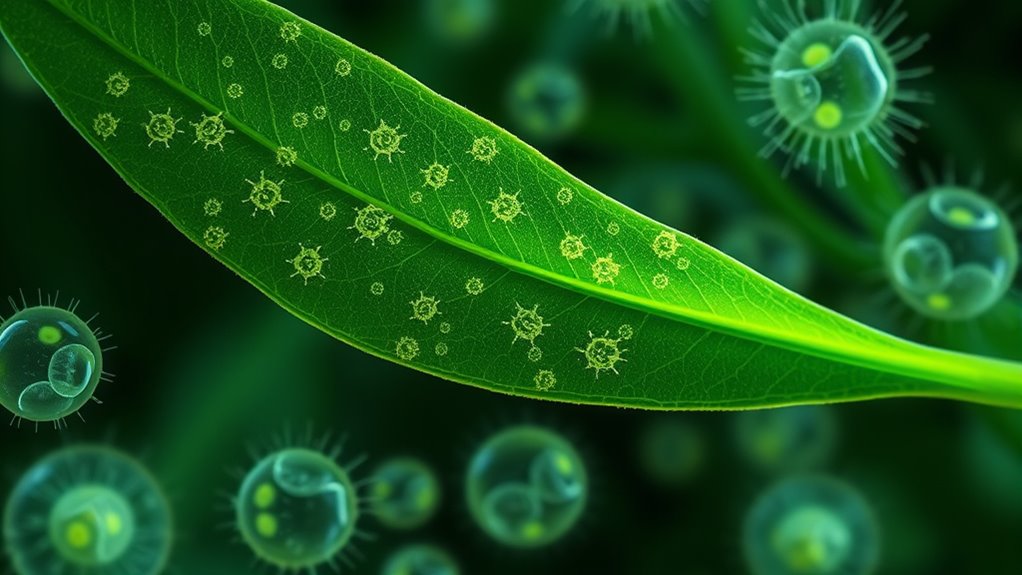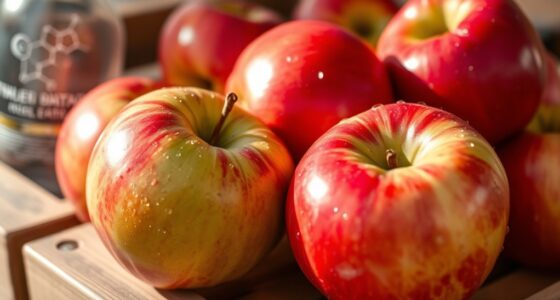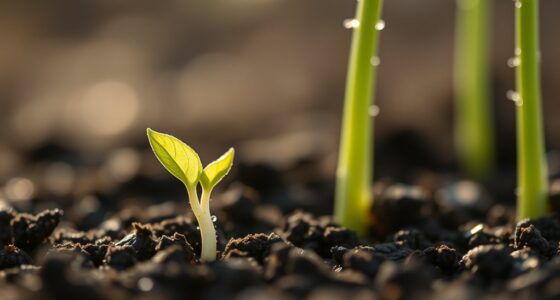Cytokinins play a key role in your plant’s cell division by promoting growth and preventing early aging, keeping tissues healthy. They work by triggering specific genetic signals that encourage cell proliferation, especially in shoots. Balancing cytokinin levels with other hormones like auxins ensures your plant grows strong without overextending or senescing too soon. If you want to discover how this intricate balance maintains plant life force, there’s more to explore ahead.
Key Takeaways
- Cytokinins promote cell division by activating genes involved in the cell cycle, supporting growth.
- They delay senescence by regulating gene expression related to aging and resource remobilization.
- The balance between cytokinins and auxins determines whether tissues undergo proliferation or aging.
- Cytokinin signaling pathways modulate transcription factors that control growth versus senescence processes.
- Proper regulation of cytokinin levels ensures coordinated growth while preventing premature aging in plants.

Cytokinins are plant hormones that play a crucial role in promoting cell division and growth. When you look at how plants develop and respond to their environment, you’ll see that these hormones are central to coordinating complex processes. They work through hormone signaling pathways that relay messages within plant cells, triggering specific responses that lead to cell proliferation. These pathways are carefully regulated to guarantee that growth occurs where and when it’s needed. As you explore this, you’ll find that cytokinins influence gene expression by affecting genetic regulation mechanisms. They activate or suppress specific genes that are essential for cell cycle progression, ensuring that cells divide at the right time and in the right locations.
Understanding how cytokinins integrate into hormone signaling pathways helps clarify how plants control their growth patterns. When cytokinins bind to receptor proteins on cell surfaces, they initiate a cascade of signals inside the cell, ultimately leading to changes in gene activity. This process is tightly controlled by the plant’s genetic regulation mechanisms, which determine the sensitivity and response to cytokinin signals. You’ll notice that these mechanisms include various transcription factors and regulatory proteins that modulate gene expression, ensuring that cell division occurs only under favorable conditions. This precise regulation prevents unchecked growth, maintaining a balance between development and resource allocation.
The interplay between cytokinins and other plant hormones, such as auxins, further refines this control. For instance, high cytokinin levels promote shoot formation, while auxins tend to encourage root development. The balance between these hormones is governed by hormone signaling pathways and genetic regulation mechanisms, which respond dynamically to environmental cues like light, nutrients, and water availability. As a result, you’ll observe that cell division isn’t just a simple process driven solely by cytokinins but a coordinated effort involving multiple signals and genetic controls that optimize plant growth.
Frequently Asked Questions
How Do Cytokinins Interact With Other Plant Hormones?
You see that cytokinins interact with other plant hormones through hormonal crosstalk and signal integration. They often work together or oppose hormones like auxins or gibberellins to regulate growth, development, and senescence. This dynamic communication allows your plant to adapt to environmental cues, balancing cell division and aging processes effectively. By managing these interactions, the plant maintains ideal growth and responds precisely to its surroundings.
What Environmental Factors Influence Cytokinin Production?
You’re likely to see that soil pH and light intensity greatly influence cytokinin production. When soil pH is ideal, cytokinin synthesis increases, promoting growth. Conversely, very acidic or alkaline soils can reduce production. Additionally, higher light intensity boosts cytokinin levels, encouraging cell division and development. In low light, cytokinin levels drop, signaling the plant to conserve resources. Adjusting these environmental factors helps manage cytokinin levels effectively.
Are Cytokinins Used in Commercial Plant Cultivation?
Yes, cytokinins are used in commercial plant cultivation. They play a key role in promoting cell division, shoot formation, and delaying aging, making them valuable in horticulture and agriculture. Their application often involves hormone synergy, where cytokinins work alongside auxins to optimize plant growth and development. This helps improve crop yields, root development, and plant longevity, ensuring more efficient and profitable cultivation practices.
How Do Cytokinins Affect Root Versus Shoot Growth?
Cytokinins primarily promote shoot elongation, often increasing shoot growth by up to 30%, but they can inhibit root development. You’ll notice that higher cytokinin levels encourage above-ground growth, while lower levels favor root development. Balancing cytokinin application helps optimize both root development and shoot elongation, ensuring healthy plant growth. Understanding this balance allows you to manipulate plant growth effectively, enhancing yields and overall plant health.
Can Cytokinins Delay Plant Aging Naturally?
Yes, cytokinins can delay plant aging naturally. By promoting cell division and delaying senescence, they help extend flower longevity and prevent early aging. When you apply cytokinins, you support healthier, longer-lasting blooms and overall plant robustness. This hormone balances growth and aging, ensuring your plants stay vibrant and fresh for a longer period, making them more attractive and resilient over time.
Conclusion
You might think that boosting cytokinins only promotes growth, but they also help delay aging in plants. By balancing cell division and senescence, cytokinins guarantee healthy development without premature aging. So, even if some believe manipulating these hormones could cause overgrowth or imbalance, understanding their precise role helps you harness their benefits responsibly. Ultimately, mastering cytokinin regulation lets you support plant vitality while avoiding unwanted side effects, making them a powerful tool in plant science.








